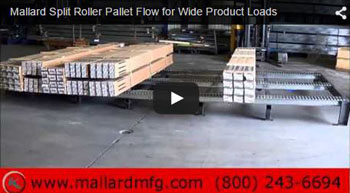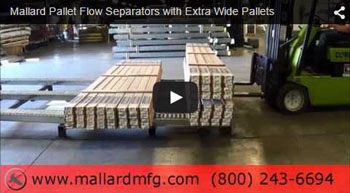6 Questions to Ask Before Buying Full Roller Pallet Flow Racking
SOLUTIONS
FOR THE TOUGHEST APPLICATIONS
"*" indicates required fields
 Why Full Roller Pallet Flow Racking?
Why Full Roller Pallet Flow Racking?
So WHEN and WHY do we use full roller pallet flow rack vs. the traditional wheeled track pallet flow? It’s a great question and one that’s asked of our sales team frequently. The truth is – every Mallard project is application-driven and in many cases, we’ll design solutions using our Magnum wheel, or in some cases steel skate wheel, because they are absolute workhorses in a busy DC, but… for some of the trickier applications, our go-to is full roller pallet flow. It’s a little more expensive but well worth the investment!
These answers to the Most Frequently Asked Questions are proof why!
1) When do you recommend full roller pallet flow racking vs. Magnum or skate wheel pallet flow? Mallard specifies full-width roller for applications using non-standard pallets. Most specialized pallets require full surface coverage to ensure proper flow, i.e. plastic pallets, pod pallets, container or specialized pallets, corrugated containers or slip pallets. Full roller is also the most flexible type of pallet flow, ideal for users who have a variety of pallet sizes and footprints. As pallet configurations change, the system design can remain the same.
2) Which applications are better suited for split roller vs full-width roller pallet flow rack? Applications requiring additional capacity are best suited for split roller pallet flow racking. Heavier pallets can cause minor deflection in full-width rollers which would negatively impact flow. Split roller is also ideal for extra-wide, unwieldy loads. The number and spacing of the flow rails is dependent on the dimensions and weight of the product load. See our split roller pallet flow in action…
3) Are galvanized rollers (vs. plain steel) really that important? We think so, especially in certain applications. Galvanizing the steel makes it virtually impervious to rust. This is particularly important in food processing and distribution. 4) What’s the benefit of spring-loaded rollers vs. other roller mounts? Spring-loaded rollers are far easier to change out if needed. Other systems require unbolting the side rails to access the rollers.
4) What’s the benefit of spring-loaded rollers vs. other roller mounts? Spring-loaded rollers are far easier to change out if needed. Other systems require unbolting the side rails to access the rollers.
5) Why does Mallard use Hex axles vs. round axles? We use hex axles specifically because they allow for greater capacity, i.e. 260 lbs. vs. 200 lbs. per roller.
6) Why use laser-cut ramp stops vs. welded stops? Laser-cut stops create a smooth surface which allows forklift operators easier access to extract pallets.
Watch split roller pallet flow with extra-wide loads in action:
Let Mallard’s pallet flow rack experts help you determine which system is right for your operations. If you’d like to try out a scenario or two in our testing lab, give us a call today!
 |
 |
